Small freshwater fish aquariums are ideal for beginners and hobbyists.
They require minimal maintenance, are cost-effective, and house a variety of colorful, small fish species that thrive in compact, well-maintained environments.
List of Small Freshwater Fish
1.Neon Tetra (Paracheirodon innesi)
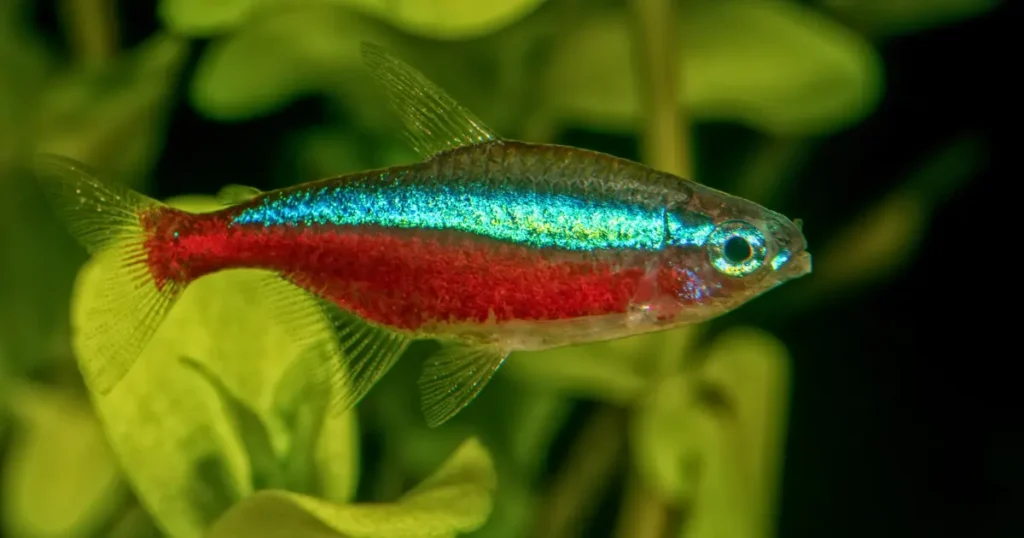
Neon Tetras are small, vibrant freshwater fish known for their striking blue and red colors. They are popular among aquarium enthusiasts due to their peaceful nature and eye-catching appearance.
Care Requirements
- Tank Size: Minimum of 10 gallons
- Water Temperature: 70-81°F (21-27°C)
- pH Level: 6.0-7.0
- Diet: Omnivorous; flake food, micro-pellets, and live or frozen foods like brine shrimp and daphnia
- Lighting: Moderate lighting
- Substrate: Fine gravel or sand
- Plants and Decor: Plenty of hiding spots with live plants and driftwood
- Water Changes: Regular water changes (25% weekly) to maintain water quality
Tank Mates
- Other small, peaceful fish such as Guppies, Harlequin Rasboras, and other Tetra species
- Bottom dwellers like Corydoras Catfish
- Avoid large or aggressive fish that may harass or eat them
2.Guppy (Poecilia reticulata)
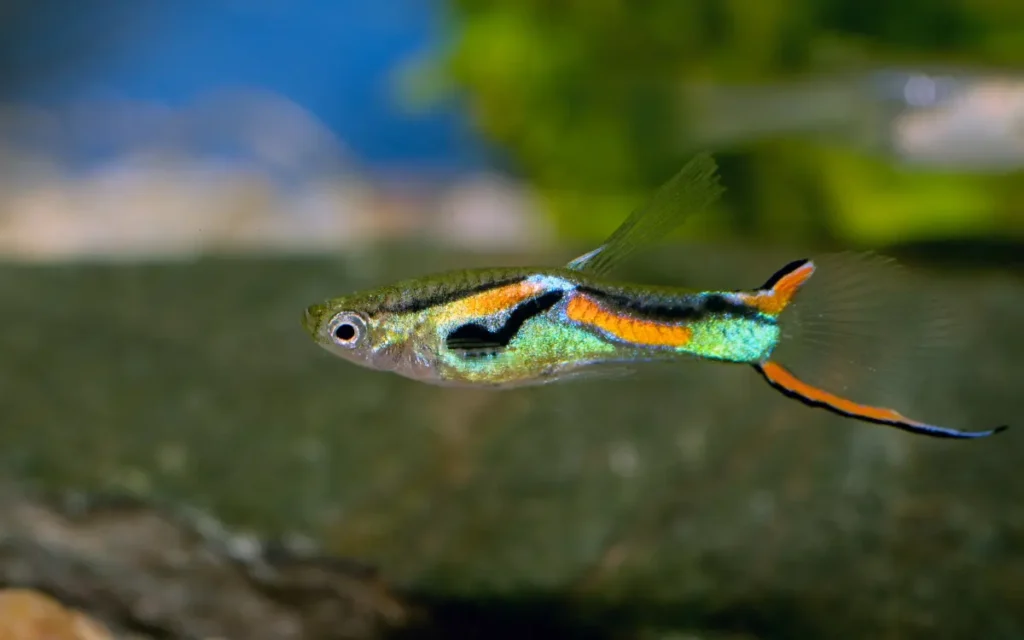
Guppies are small, colorful freshwater fish popular among aquarium hobbyists for their bright colors and active behavior. They are easy to care for and breed, making them a great choice for beginners.
Care Requirements
- Tank Size: Minimum of 5 gallons
- Water Temperature: 72-82°F (22-28°C)
- pH Level: 6.8-7.8
- Diet: Omnivorous; flake food, micro-pellets, and live or frozen foods like brine shrimp and daphnia
- Lighting: Moderate lighting
- Substrate: Fine gravel or sand
- Plants and Decor: Live plants and hiding spots with decorations
- Water Changes: Regular water changes (25% weekly) to maintain water quality
Tank Mates
- Other peaceful community fish such as Neon Tetras, Corydoras Catfish, and Harlequin Rasboras
- Avoid fin-nipping species like Tiger Barbs
- Other livebearers like Platies and Mollies
3.Ember Tetra (Hyphessobrycon amandae)
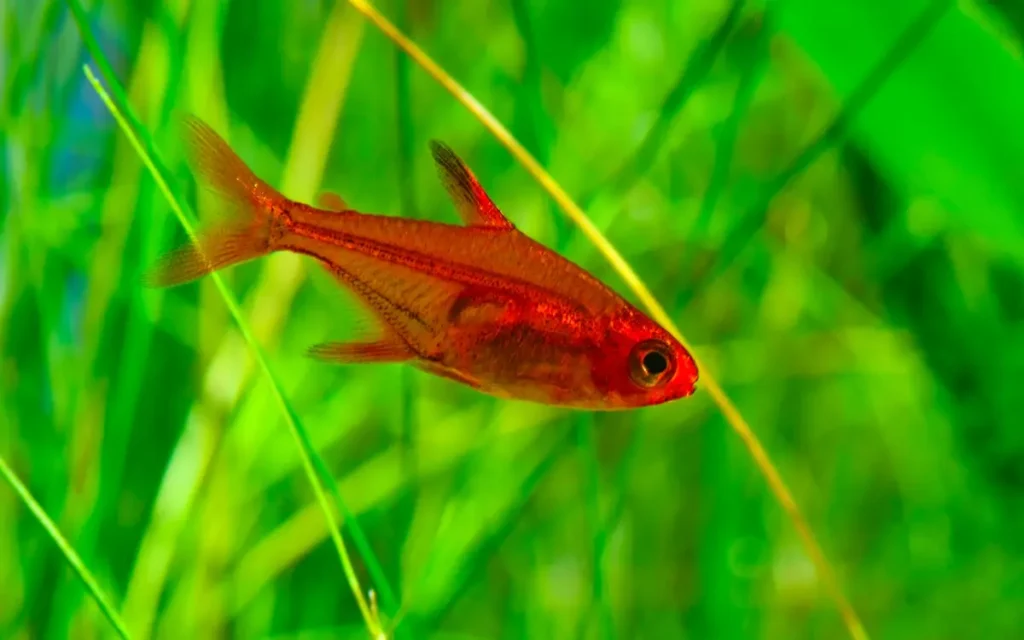
Ember Tetras are small, peaceful freshwater fish known for their bright orange coloration. They are popular in nano aquariums due to their small size and vibrant color, making them a delightful addition to planted tanks.
Care Requirements
- Tank Size: Minimum of 10 gallons
- Water Temperature: 73-84°F (23-29°C)
- pH Level: 5.5-7.0
- Diet: Omnivorous; high-quality flake food, micro-pellets, and live or frozen foods like brine shrimp and daphnia
- Lighting: Moderate lighting
- Substrate: Fine gravel or sand
- Plants and Decor: Dense planting with live plants and plenty of hiding spots
- Water Changes: Regular water changes (25% weekly) to maintain water quality
Tank Mates
- Other small, peaceful fish such as Neon Tetras, Guppies, and Harlequin Rasboras
- Bottom dwellers like Corydoras Catfish
- Avoid large or aggressive fish that may harass or eat them
4.Pygmy Corydoras (Corydoras pygmaeus)
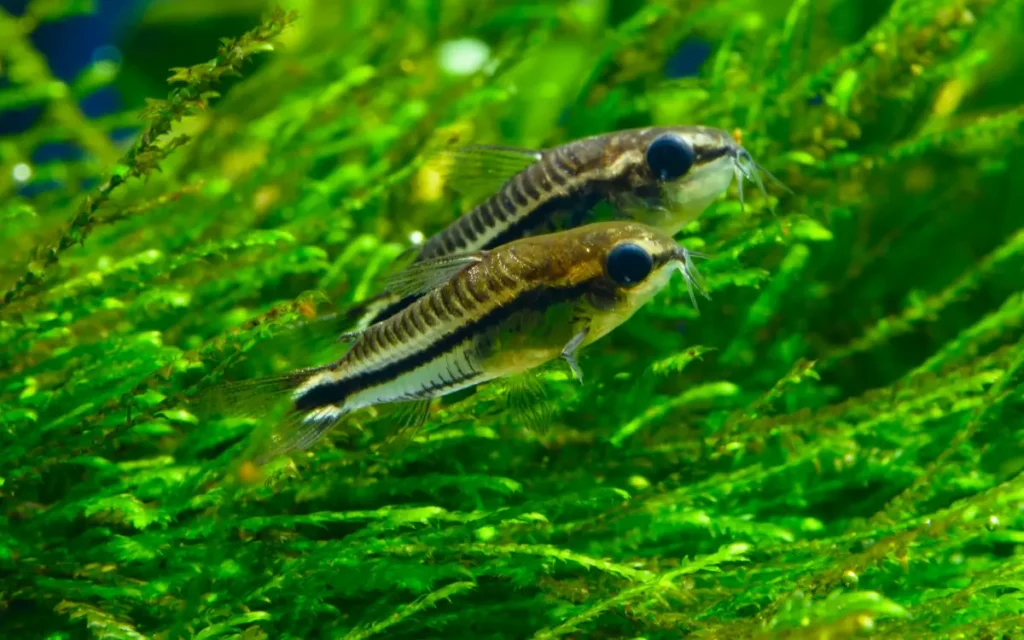
Pygmy Corydoras are tiny, peaceful bottom-dwelling fish known for their gentle nature and schooling behavior. They are popular in nano aquariums and community tanks due to their small size and active, friendly behavior.
Care Requirements
- Tank Size: Minimum of 10 gallons
- Water Temperature: 72-79°F (22-26°C)
- pH Level: 6.4-7.4
- Diet: Omnivorous; high-quality sinking pellets, flakes, and live or frozen foods like bloodworms and brine shrimp
- Lighting: Moderate to low lighting
- Substrate: Soft sand or fine gravel to protect their delicate barbels
- Plants and Decor: Dense planting with live plants, hiding spots, and smooth surfaces to rest on
- Water Changes: Regular water changes (25% weekly) to maintain water quality
Tank Mates
- Other small, peaceful fish such as Neon Tetras, Ember Tetras, and Guppies
- Other Corydoras species
- Avoid aggressive or large fish that may intimidate or harm them
5.White Cloud Mountain Minnow (Tanichthys albonubes)
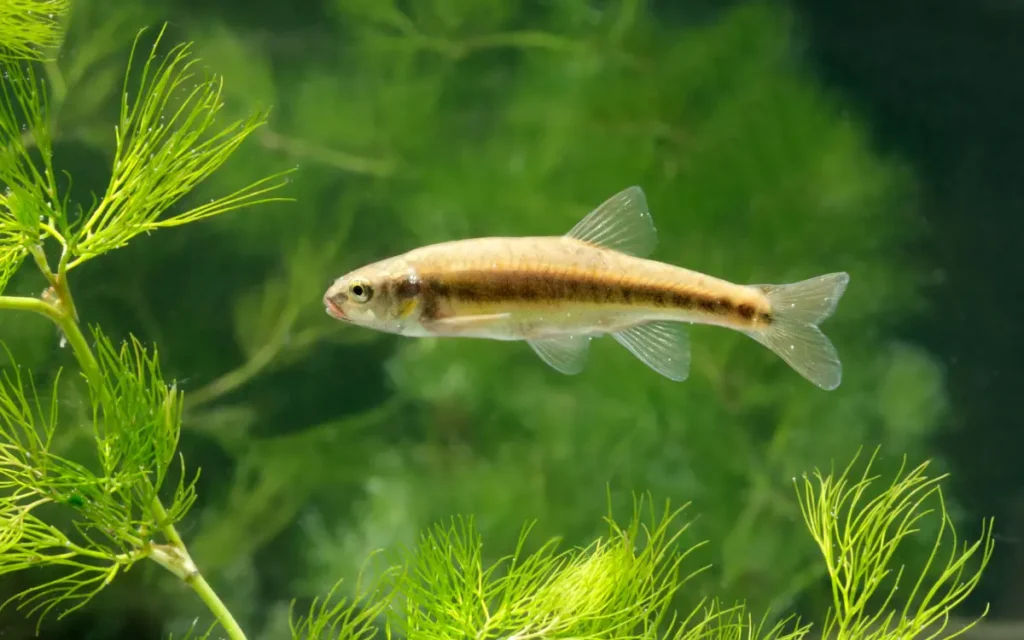
White Cloud Mountain Minnows are small, hardy freshwater fish known for their easy care and beautiful coloration. They are ideal for beginners and can thrive in a variety of tank conditions, making them a versatile choice for community aquariums.
Care Requirements
- Tank Size: Minimum of 10 gallons
- Water Temperature: 64-72°F (18-22°C)
- pH Level: 6.0-8.0
- Diet: Omnivorous; high-quality flake food, micro-pellets, and live or frozen foods like brine shrimp and daphnia
- Lighting: Moderate lighting
- Substrate: Fine gravel or sand
- Plants and Decor: Live plants and hiding spots with decorations
- Water Changes: Regular water changes (25% weekly) to maintain water quality
Tank Mates
- Other peaceful community fish such as Neon Tetras, Guppies, and Corydoras Catfish
- Hardy fish that can tolerate cooler water temperatures
- Avoid large or aggressive fish that may harass or eat them
6.Endler’s Livebearer (Poecilia wingei)
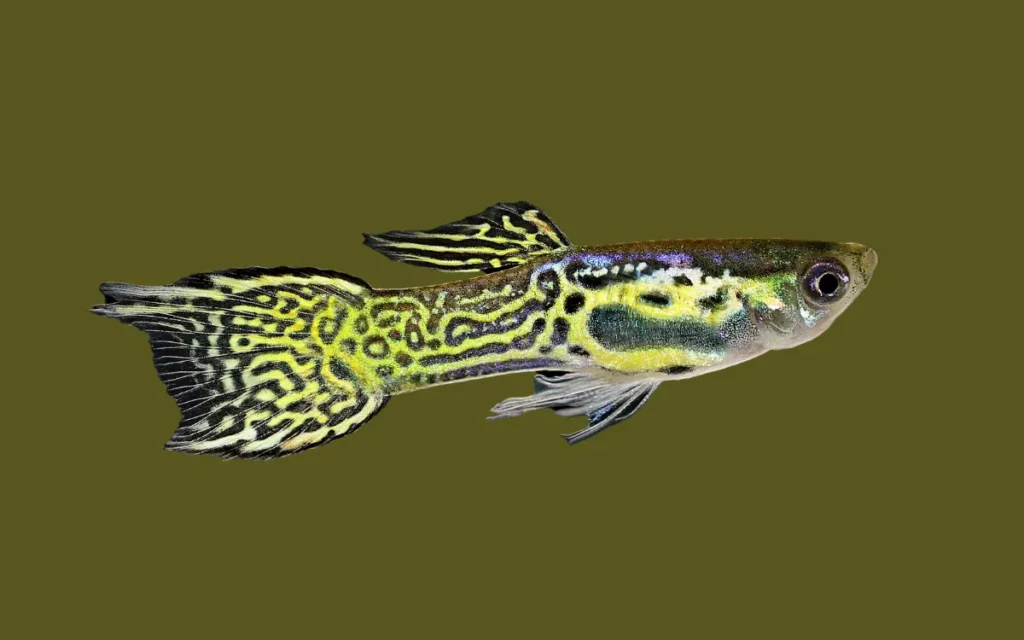
Endler’s Livebearers are small, colorful freshwater fish closely related to guppies. They are prized for their vibrant colors and lively behavior. Easy to care for and breed, they are an excellent choice for both beginner and experienced aquarists.
Care Requirements
- Tank Size: Minimum of 5 gallons
- Water Temperature: 72-82°F (22-28°C)
- pH Level: 6.7-8.5
- Diet: Omnivorous; high-quality flake food, micro-pellets, and live or frozen foods like brine shrimp and daphnia
- Lighting: Moderate lighting
- Substrate: Fine gravel or sand
- Plants and Decor: Live plants, hiding spots, and decorations for enrichment
- Water Changes: Regular water changes (25% weekly) to maintain water quality
Tank Mates
- Other small, peaceful fish such as Neon Tetras, Guppies, and Corydoras Catfish
- Other livebearers like Mollies and Platies
- Avoid large or aggressive fish that may harass or eat them
7.Sparkling Gourami (Trichopsis pumila)

Sparkling Gouramis are small, beautifully iridescent freshwater fish known for their subtle sparkling appearance and peaceful nature. They are an excellent choice for nano aquariums and provide a unique, shimmering addition to any tank.
Care Requirements
- Tank Size: Minimum of 10 gallons
- Water Temperature: 76-82°F (24-28°C)
- pH Level: 6.0-7.5
- Diet: Omnivorous; high-quality flake food, micro-pellets, and live or frozen foods like brine shrimp and daphnia
- Lighting: Low to moderate lighting
- Substrate: Fine gravel or sand
- Plants and Decor: Dense planting with live plants, hiding spots, and floating plants for cover
- Water Changes: Regular water changes (25% weekly) to maintain water quality
Tank Mates
- Other small, peaceful fish such as Neon Tetras, Guppies, and Harlequin Rasboras
- Bottom dwellers like Corydoras Catfish
- Avoid aggressive or large fish that may intimidate or harm them
8.Pea Puffer (Carinotetraodon travancoricus)
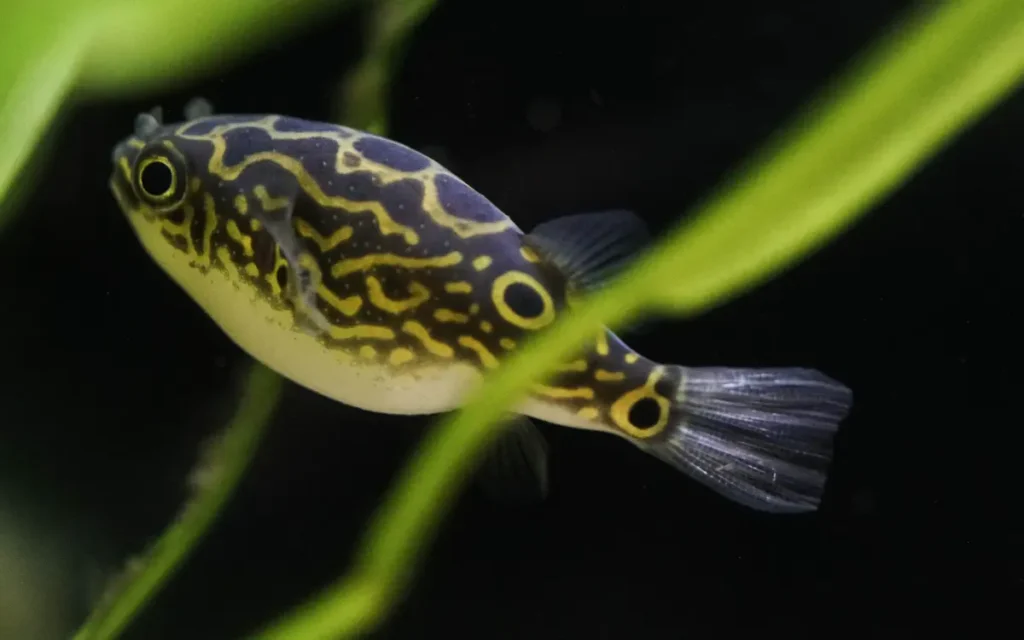
Pea Puffers, also known as Dwarf Puffers, are tiny, highly intelligent freshwater fish known for their inquisitive nature and vibrant coloration. Despite their small size, they have a big personality and can be fascinating to watch.
Care Requirements
- Tank Size: Minimum of 5 gallons for a single puffer, 10 gallons for a small group
- Water Temperature: 74-82°F (23-28°C)
- pH Level: 6.5-7.5
- Diet: Carnivorous; primarily live or frozen foods like bloodworms, brine shrimp, and snails
- Lighting: Moderate lighting
- Substrate: Fine gravel or sand
- Plants and Decor: Dense planting with live plants, hiding spots, and plenty of decorations to explore
- Water Changes: Regular water changes (25% weekly) to maintain water quality
Tank Mates
- Best kept in a species-only tank due to their potential aggression toward other fish
- Can be kept with fast-moving, peaceful fish in larger tanks with plenty of hiding spaces
- Avoid slow-moving or long-finned fish that may be nipped at
- Can be kept with shrimp and snails, but they may become part of their diet
9.Harlequin Rasbora (Trigonostigma heteromorpha)
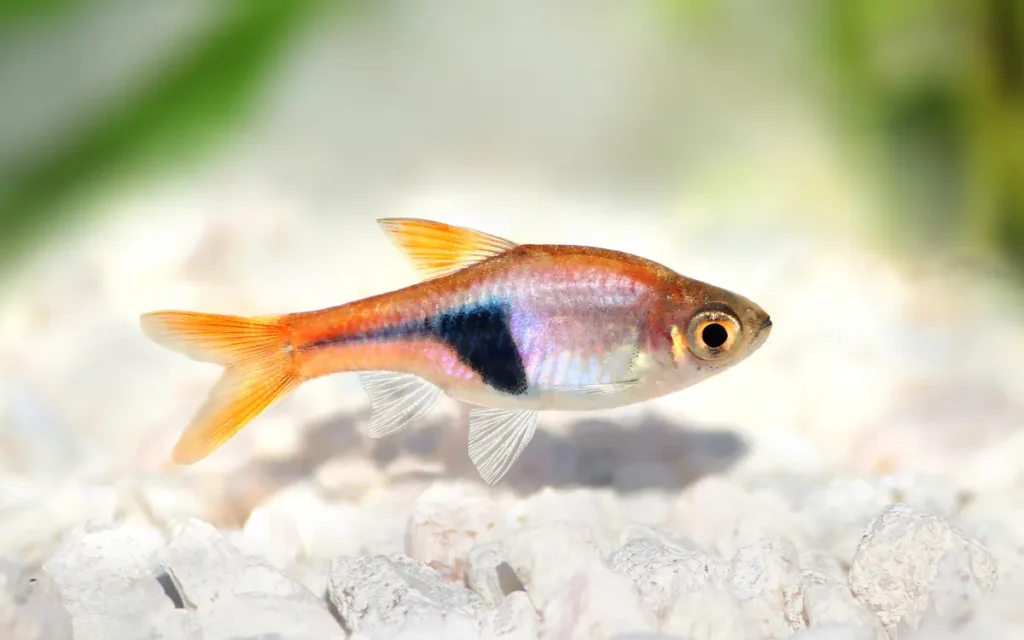
Harlequin Rasboras are small, colorful freshwater fish known for their striking black triangular markings and vibrant orange-red bodies. They are peaceful, schooling fish that are popular in community tanks and add a splash of color to any aquarium.
Care Requirements
- Tank Size: Minimum of 10 gallons
- Water Temperature: 72-81°F (22-27°C)
- pH Level: 6.0-7.5
- Diet: Omnivorous; high-quality flake food, micro-pellets, and live or frozen foods like brine shrimp and daphnia
- Lighting: Moderate lighting
- Substrate: Fine gravel or sand
- Plants and Decor: Live plants and open swimming spaces with some hiding spots
- Water Changes: Regular water changes (25% weekly) to maintain water quality
Tank Mates
- Other small, peaceful fish such as Neon Tetras, Guppies, and Corydoras Catfish
- Other Rasbora species
- Bottom dwellers like Otocinclus Catfish
- Avoid large or aggressive fish that may harass or eat them
8.Cherry Barb (Puntius titteya)
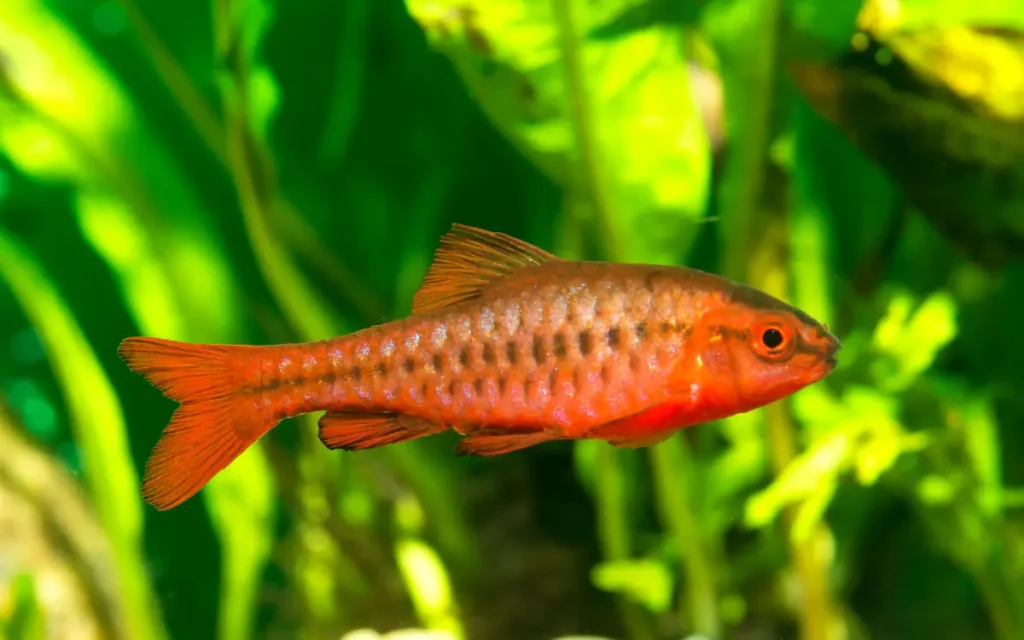
Cherry Barbs are small, peaceful freshwater fish known for their bright red coloration, particularly in males. They are popular in community tanks due to their vibrant appearance and calm demeanor, making them an excellent choice for both beginners and experienced aquarists.
Care Requirements
- Tank Size: Minimum of 10 gallons
- Water Temperature: 73-81°F (23-27°C)
- pH Level: 6.0-8.0
- Diet: Omnivorous; high-quality flake food, micro-pellets, and live or frozen foods like brine shrimp and daphnia
- Lighting: Moderate lighting
- Substrate: Fine gravel or sand
- Plants and Decor: Live plants and hiding spots with decorations
- Water Changes: Regular water changes (25% weekly) to maintain water quality
Tank Mates
- Other small, peaceful fish such as Neon Tetras, Harlequin Rasboras, and Guppies
- Bottom dwellers like Corydoras Catfish
- Other barb species
- Avoid large or aggressive fish that may harass or eat them
9.Glowlight Tetra (Hemigrammus erythrozonus)
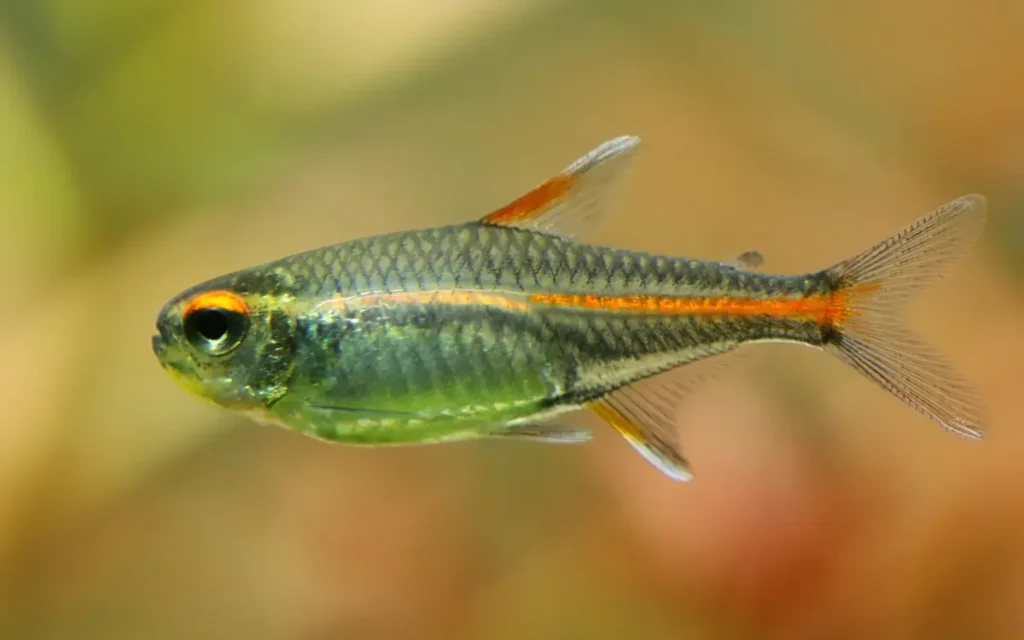
Glowlight Tetras are small, peaceful freshwater fish known for their distinctive orange-red stripe that runs along their bodies, giving them a glowing appearance. They are a popular choice for community tanks due to their vibrant coloration and easy-going nature.
Care Requirements
- Tank Size: Minimum of 10 gallons
- Water Temperature: 72-82°F (22-28°C)
- pH Level: 5.5-7.5
- Diet: Omnivorous; high-quality flake food, micro-pellets, and live or frozen foods like brine shrimp and daphnia
- Lighting: Moderate lighting
- Substrate: Fine gravel or sand
- Plants and Decor: Live plants, hiding spots, and driftwood
- Water Changes: Regular water changes (25% weekly) to maintain water quality
Tank Mates
- Other small, peaceful fish such as Neon Tetras, Harlequin Rasboras, and Guppies
- Bottom dwellers like Corydoras Catfish
- Other tetra species
- Avoid large or aggressive fish that may harass or eat them
10.Panda Corydoras (Corydoras panda)
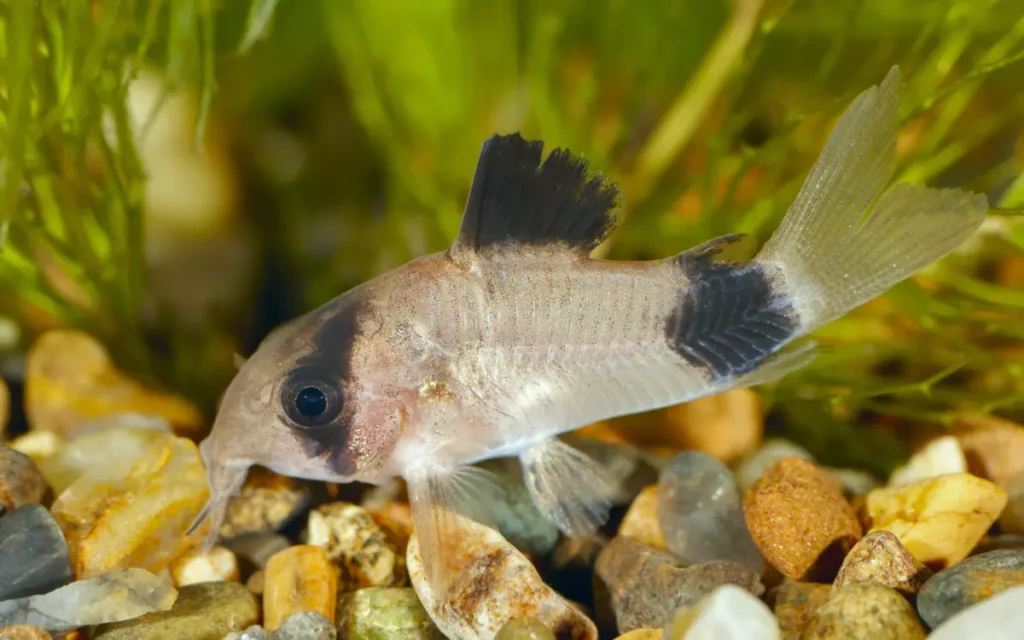
Panda Corydoras are small, peaceful bottom-dwelling fish known for their distinctive black and white markings resembling a panda. They are popular in community tanks for their playful behavior and effective tank-cleaning habits.
Care Requirements
- Tank Size: Minimum of 10 gallons
- Water Temperature: 68-77°F (20-25°C)
- pH Level: 6.0-7.0
- Diet: Omnivorous; high-quality sinking pellets, flakes, and live or frozen foods like bloodworms and brine shrimp
- Lighting: Moderate lighting
- Substrate: Soft sand or fine gravel to protect their delicate barbels
- Plants and Decor: Dense planting with live plants, hiding spots, and smooth surfaces to rest on
- Water Changes: Regular water changes (25% weekly) to maintain water quality
Tank Mates
- Other small, peaceful fish such as Neon Tetras, Harlequin Rasboras, and Guppies
- Other Corydoras species
- Avoid aggressive or large fish that may intimidate or harm them
11.Mickey Mouse Platy (Xiphophorus maculatus)
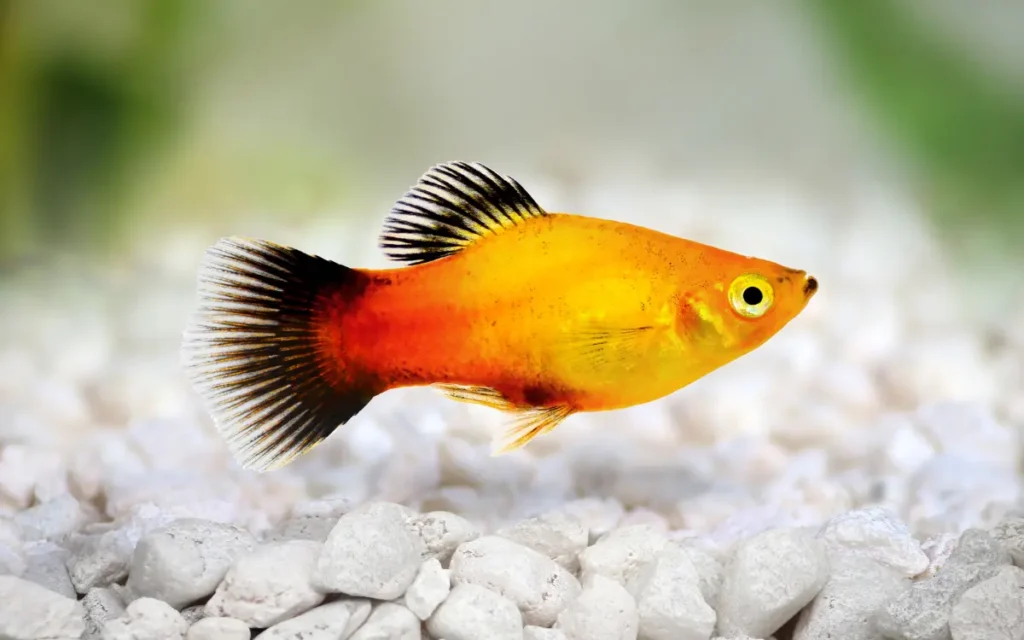
Mickey Mouse Platies are small, vibrant freshwater fish named for the distinctive Mickey Mouse-shaped markings near their tails. They are hardy, easy to care for, and come in various colors, making them a popular choice for both beginner and experienced aquarists.
Care Requirements
- Tank Size: Minimum of 10 gallons
- Water Temperature: 70-77°F (21-25°C)
- pH Level: 7.0-8.2
- Diet: Omnivorous; high-quality flake food, micro-pellets, and live or frozen foods like brine shrimp and daphnia
- Lighting: Moderate lighting
- Substrate: Fine gravel or sand
- Plants and Decor: Live plants, hiding spots, and decorations
- Water Changes: Regular water changes (25% weekly) to maintain water quality
Tank Mates
- Other peaceful community fish such as Neon Tetras, Guppies, and Corydoras Catfish
- Other livebearers like Mollies and Swordtails
- Avoid large or aggressive fish that may harass or eat them
12.Zebra Danio (Danio rerio)
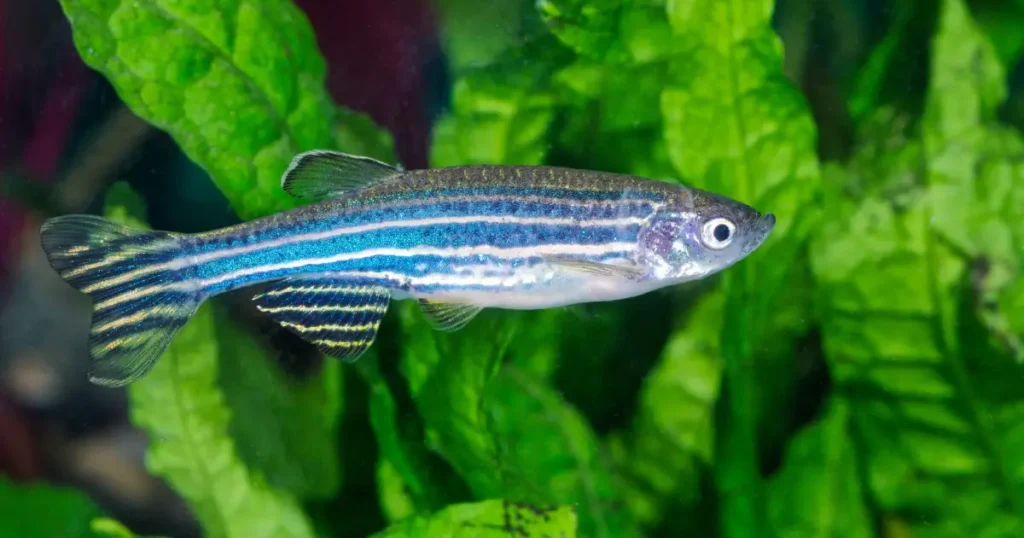
Zebra Danios are small, hardy freshwater fish known for their distinctive horizontal blue and silver stripes. They are active, peaceful, and easy to care for, making them a popular choice for community aquariums and beginner aquarists.
Care Requirements
- Tank Size: Minimum of 10 gallons
- Water Temperature: 64-77°F (18-25°C)
- pH Level: 6.5-7.5
- Diet: Omnivorous; high-quality flake food, micro-pellets, and live or frozen foods like brine shrimp and daphnia
- Lighting: Moderate lighting
- Substrate: Fine gravel or sand
- Plants and Decor: Live plants, open swimming spaces, and decorations for enrichment
- Water Changes: Regular water changes (25% weekly) to maintain water quality
Tank Mates
- Other small, peaceful fish such as Neon Tetras, Harlequin Rasboras, and Guppies
- Bottom dwellers like Corydoras Catfish and Otocinclus
- Other danio species
- Avoid large or aggressive fish that may harass or eat them
13.Betta Fish (Betta splendens)
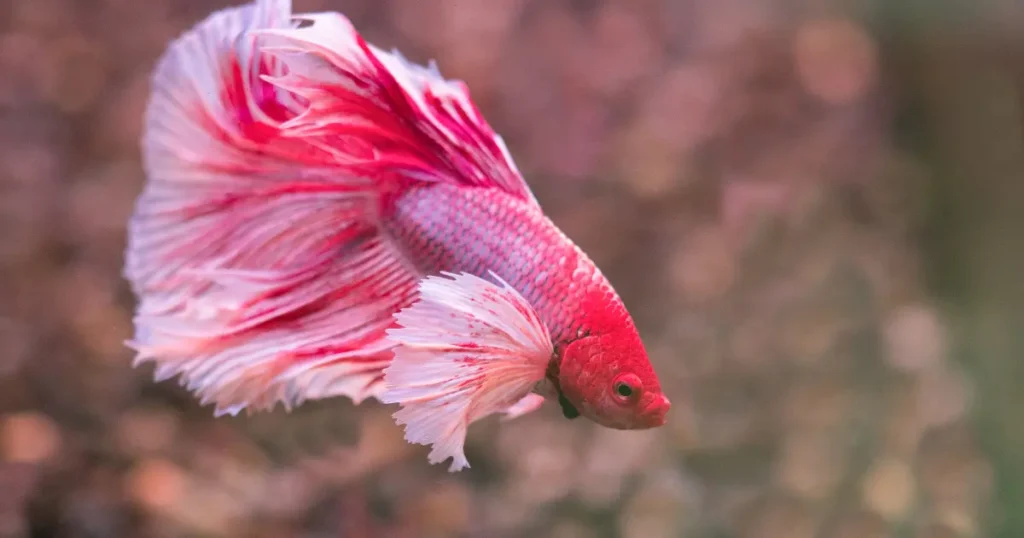
Betta Fish, also known as Siamese Fighting Fish, are renowned for their stunning colors and flowing fins. They are popular for their beauty and unique behavior. Bettas are territorial and are best kept alone or with carefully selected tank mates.
Care Requirements
- Tank Size: Minimum of 5 gallons
- Water Temperature: 76-82°F (24-28°C)
- pH Level: 6.5-7.5
- Diet: Carnivorous; high-quality betta pellets, live or frozen foods like bloodworms, brine shrimp, and daphnia
- Lighting: Moderate lighting
- Substrate: Fine gravel or sand
- Plants and Decor: Live or silk plants, hiding spots, and decorations that provide shelter without sharp edges
- Water Changes: Regular water changes (25% weekly) to maintain water quality
Tank Mates
- Ideally kept alone due to their aggressive nature
- If tank mates are desired, choose peaceful species such as Corydoras Catfish, small snails, or shrimp
- Avoid other male Bettas, fin-nipping species, and fish with similar appearance or bright colors
14.Otocinclus Catfish (Otocinclus spp.)
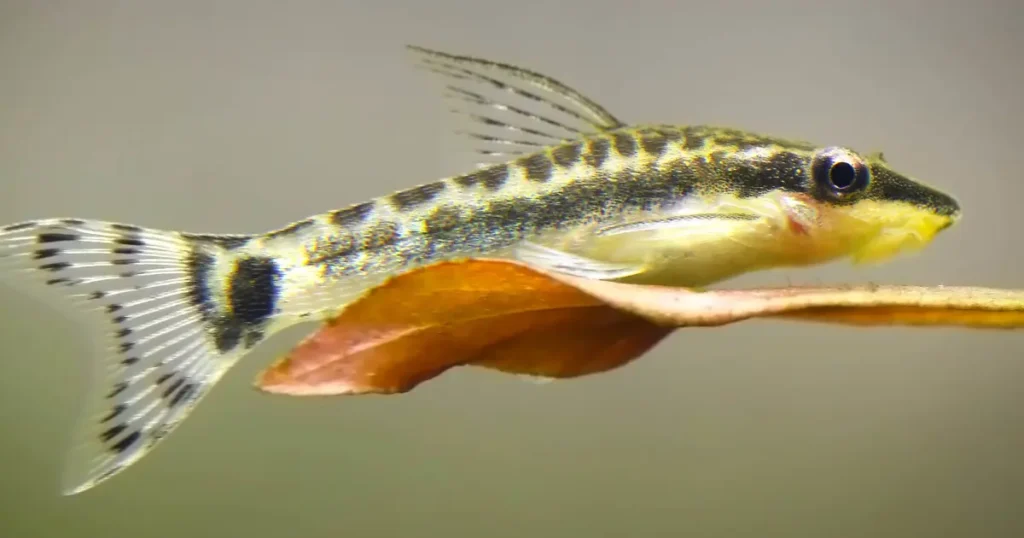
Otocinclus Catfish, often referred to as “Otos,” are small, peaceful freshwater fish known for their algae-eating capabilities. They are popular in planted aquariums and community tanks for their diligent cleaning and non-aggressive nature.
Care Requirements
- Tank Size: Minimum of 10 gallons
- Water Temperature: 72-79°F (22-26°C)
- pH Level: 6.8-7.5
- Diet: Herbivorous; primarily algae, supplemented with algae wafers and blanched vegetables like zucchini and cucumber
- Lighting: Moderate lighting
- Substrate: Fine gravel or sand
- Plants and Decor: Live plants, driftwood, and rocks to provide hiding spots and surfaces for algae growth
- Water Changes: Regular water changes (25% weekly) to maintain water quality
Tank Mates
- Other small, peaceful fish such as Neon Tetras, Harlequin Rasboras, and Guppies
- Other bottom dwellers like Corydoras Catfish
- Avoid large or aggressive fish that may harass or eat them
15.Serpae Tetra (Hyphessobrycon eques)
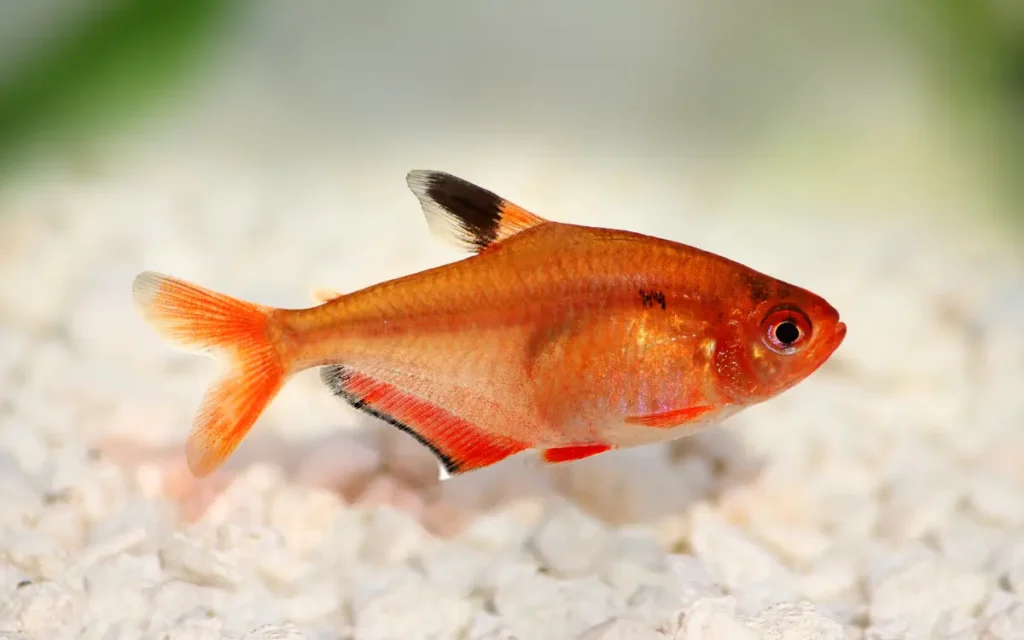
Serpae Tetras are small, vibrant freshwater fish known for their striking red color and distinctive black dorsal fin. They are active and schooling fish, making them an attractive addition to community tanks. However, they can be fin-nippers, so careful consideration of tank mates is necessary.
Care Requirements
- Tank Size: Minimum of 20 gallons (to accommodate their active schooling nature)
- Water Temperature: 72-79°F (22-26°C)
- pH Level: 5.5-7.0
- Diet: Omnivorous; high-quality flake food, micro-pellets, and live or frozen foods like brine shrimp and bloodworms
- Lighting: Moderate lighting
- Substrate: Fine gravel or sand
- Plants and Decor: Live plants, driftwood, and rocks to provide hiding spots and create a natural environment
- Water Changes: Regular water changes (25% weekly) to maintain water quality
Tank Mates
- Best kept with other fast-moving or similarly-sized fish such as Zebra Danios, Harlequin Rasboras, and larger Tetras
- Bottom dwellers like Corydoras Catfish
- Avoid slow-moving or long-finned fish such as Bettas and Guppies to prevent fin-nipping
- Keeping them in groups of at least 6 can help reduce aggressive behavior
16.Tiger Barb (Puntigrus tetrazona)
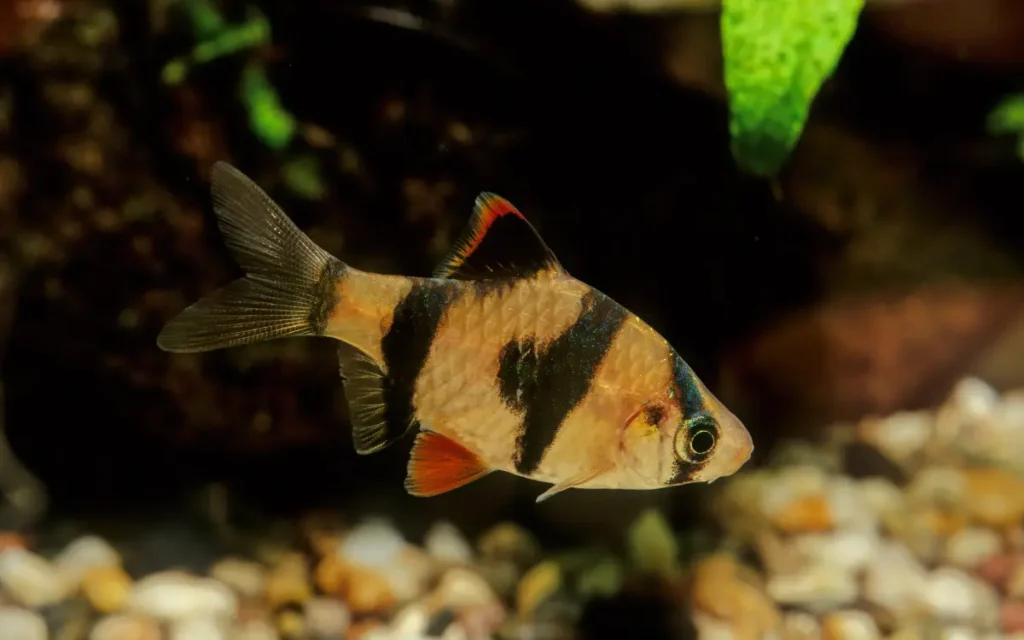
Tiger Barbs are small, energetic freshwater fish known for their bold black stripes and vibrant orange bodies. They are active and schooling fish, often adding a lively presence to community tanks. However, they have a reputation for being fin-nippers, so careful selection of tank mates is essential.
Care Requirements
- Tank Size: Minimum of 20 gallons (to accommodate their active schooling nature)
- Water Temperature: 74-79°F (23-26°C)
- pH Level: 6.0-7.5
- Diet: Omnivorous; high-quality flake food, micro-pellets, and live or frozen foods like brine shrimp and bloodworms
- Lighting: Moderate lighting
- Substrate: Fine gravel or sand
- Plants and Decor: Live plants, driftwood, and rocks to provide hiding spots and create a natural environment
- Water Changes: Regular water changes (25% weekly) to maintain water quality
Tank Mates
- Best kept with other fast-moving or similarly-sized fish such as Zebra Danios, Harlequin Rasboras, and larger Tetras
- Bottom dwellers like Corydoras Catfish
- Avoid slow-moving or long-finned fish such as Bettas and Guppies to prevent fin-nipping
- Keeping them in groups of at least 6 can help reduce aggressive behavior and fin-nipping tendencies
17.Swordtail (Xiphophorus hellerii)
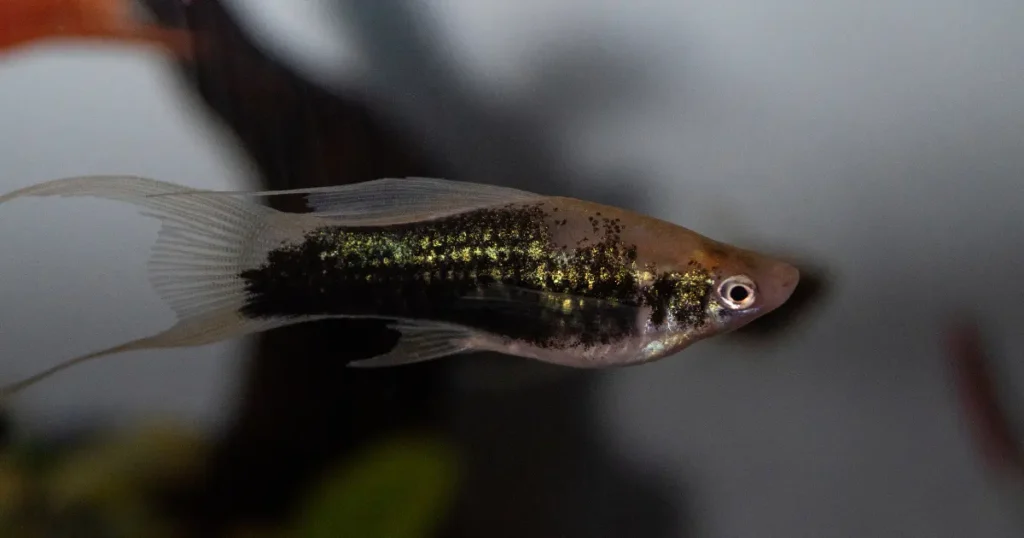
Swordtails are popular freshwater fish known for their distinctive sword-like extension on the male’s tail. They are hardy and active and come in various colors, making them a great choice for community tanks. Swordtails are livebearers, meaning they give birth to live young.
Care Requirements
- Tank Size: Minimum of 15-20 gallons
- Water Temperature: 72-82°F (22-28°C)
- pH Level: 7.0-8.4
- Diet: Omnivorous; high-quality flake food, micro-pellets, and live or frozen foods like brine shrimp and daphnia
- Lighting: Moderate lighting
- Substrate: Fine gravel or sand
- Plants and Decor: Live plants, hiding spots, and open swimming spaces
- Water Changes: Regular water changes (25% weekly) to maintain water quality
Tank Mates
- Other peaceful community fish such as Neon Tetras, Guppies, and Corydoras Catfish
- Other livebearers like Platies and Mollies
- Avoid large or aggressive fish that may harass or eat them
- They can coexist with other Swordtails but be mindful of potential overpopulation due to their breeding habits
18.Dwarf Gourami (Trichogaster lalius)
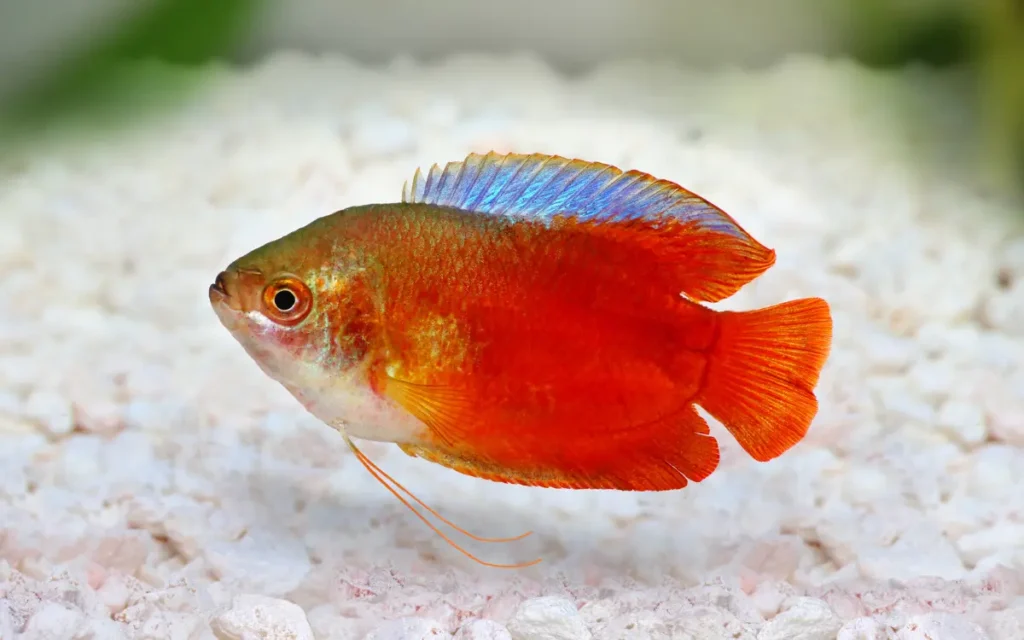
Dwarf Gouramis are small, vibrantly colored freshwater fish known for their striking blue and red patterns. They are peaceful and relatively easy to care for, making them a popular choice for community tanks and beginner aquarists.
Care Requirements
- Tank Size: Minimum of 10 gallons
- Water Temperature: 77-78°F (25-26°C)
- pH Level: 6.0-7.5
- Diet: Omnivorous; high-quality flake food, micro-pellets, and live or frozen foods like brine shrimp and bloodworms
- Lighting: Moderate lighting
- Substrate: Fine gravel or sand
- Plants and Decor: Live plants, hiding spots, and floating plants to provide cover and simulate their natural habitat
- Water Changes: Regular water changes (25% weekly) to maintain water quality
Tank Mates
- Other peaceful community fish such as Neon Tetras, Harlequin Rasboras, and Corydoras Catfish
- Avoid aggressive or fin-nipping fish that may harass them
- Can be kept with other gourami species, but monitored for territorial behavior
- Ideal tank mates also include small, non-aggressive bottom dwellers like Otocinclus Catfish
19.Black Phantom Tetra (Hyphessobrycon megalopterus)
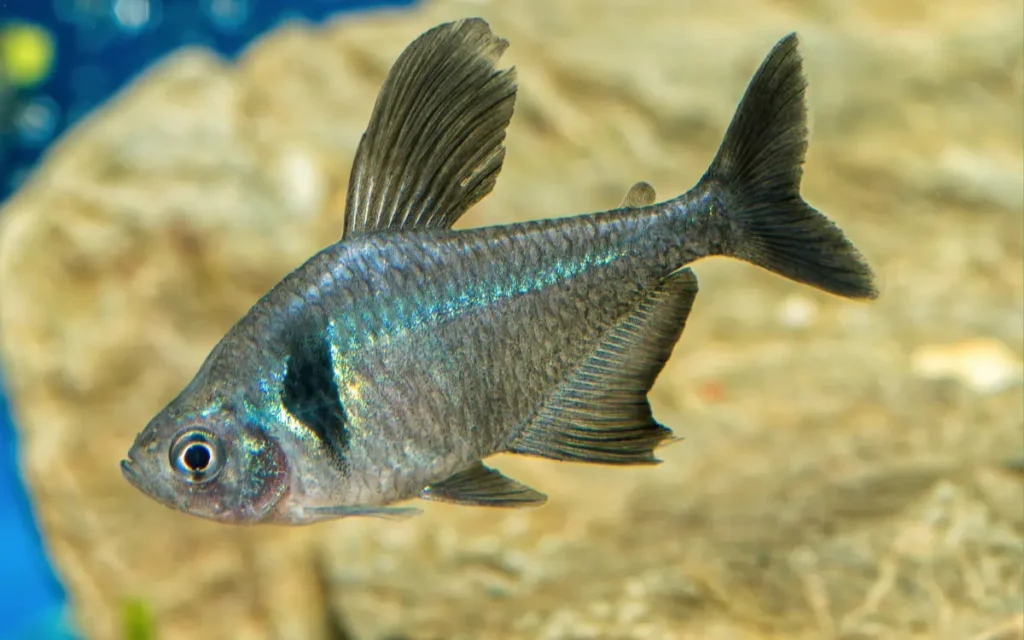
Black Phantom Tetras are small, peaceful freshwater fish known for their elegant black and silver coloration and distinctive black fin markings. They are active and schooling fish, making them an attractive addition to community tanks.
Care Requirements
- Tank Size: Minimum of 10 gallons
- Water Temperature: 72-82°F (22-28°C)
- pH Level: 6.0-7.5
- Diet: Omnivorous; high-quality flake food, micro-pellets, and live or frozen foods like brine shrimp and bloodworms
- Lighting: Moderate lighting
- Substrate: Fine gravel or sand
- Plants and Decor: Live plants, driftwood, and rocks to provide hiding spots and create a natural environment
- Water Changes: Regular water changes (25% weekly) to maintain water quality
Tank Mates
- Other small, peaceful fish such as Neon Tetras, Harlequin Rasboras, and Guppies
- Bottom dwellers like Corydoras Catfish and Otocinclus
- Other tetra species to enhance schooling behavior
- Avoid large or aggressive fish that may harass or eat them
20.Black Ruby Barb (Pethia nigrofasciata)
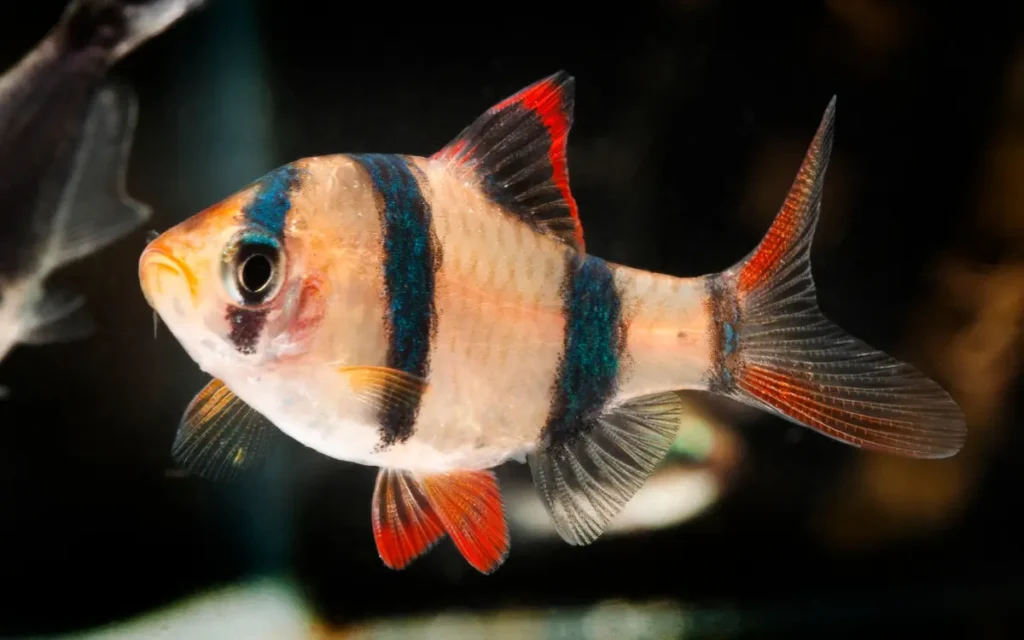
Black Ruby Barbs are small, attractive freshwater fish known for their striking coloration, which changes as they mature. Males develop a deep red hue, especially during breeding, while females retain a more subdued coloration. They are active and social, making them a lively addition to community tanks.
Care Requirements
- Tank Size: Minimum of 20 gallons
- Water Temperature: 72-79°F (22-26°C)
- pH Level: 6.0-7.5
- Diet: Omnivorous; high-quality flake food, micro-pellets, and live or frozen foods like brine shrimp and bloodworms
- Lighting: Moderate lighting
- Substrate: Fine gravel or sand
- Plants and Decor: Live plants, driftwood, and rocks to provide hiding spots and create a natural environment
- Water Changes: Regular water changes (25% weekly) to maintain water quality
Tank Mates
- Other peaceful community fish such as Neon Tetras, Harlequin Rasboras, and Corydoras Catfish
- Other barbs like Cherry Barbs and Tiger Barbs (in a large enough tank to minimize aggression)
- Bottom dwellers like Corydoras Catfish and Otocinclus
- Avoid slow-moving or long-finned fish that may be nipped at, such as Bettas
21.Molly (Poecilia sphenops)
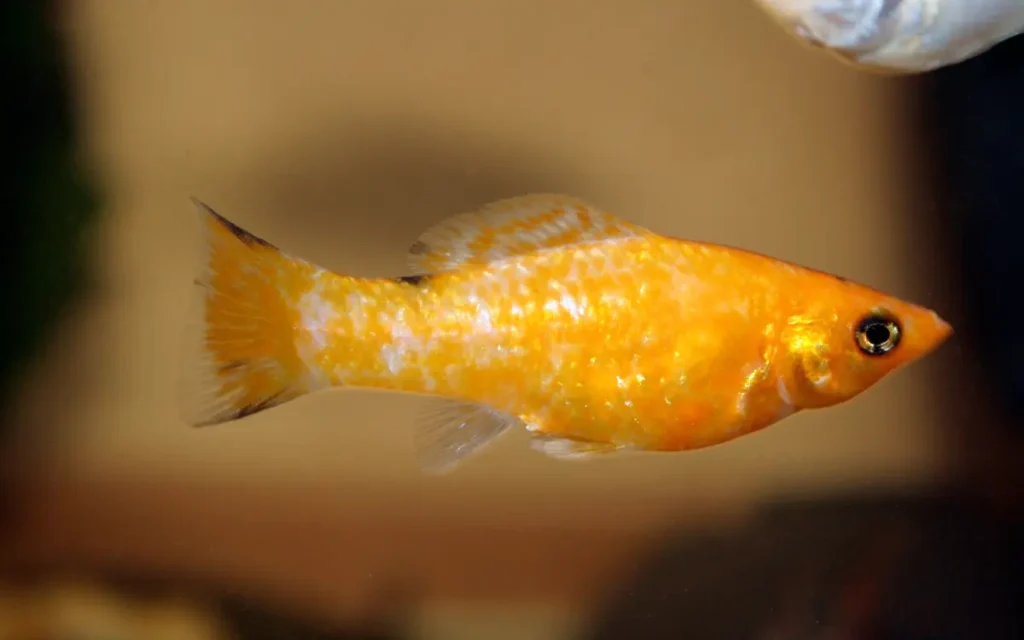
Mollies are hardy, adaptable freshwater fish known for their wide range of colors and patterns. They are livebearers, giving birth to live young, and are popular among both beginner and experienced aquarists due to their peaceful nature and ease of care.
Care Requirements
- Tank Size: Minimum of 10 gallons
- Water Temperature: 72-78°F (22-26°C)
- pH Level: 7.5-8.5
- Diet: Omnivorous; high-quality flake food, algae wafers, and live or frozen foods like brine shrimp and bloodworms
- Lighting: Moderate lighting
- Substrate: Fine gravel or sand
- Plants and Decor: Live plants, hiding spots, and open swimming areas
- Water Changes: Regular water changes (25% weekly) to maintain water quality
Tank Mates
- Other peaceful community fish such as Neon Tetras, Guppies, and Corydoras Catfish
- Other livebearers like Platies and Swordtails
- Avoid large or aggressive fish that may harass or eat them
- Mollies can coexist with small, peaceful bottom dwellers like Otocinclus and Corydoras Catfish
22.German Blue Ram (Mikrogeophagus ramirezi)
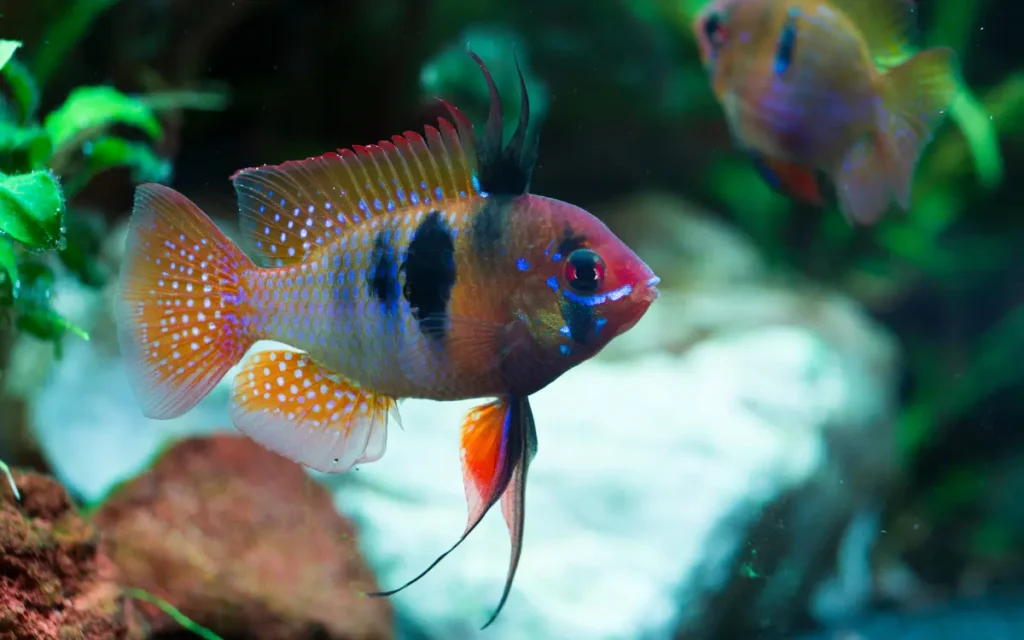
German Blue Rams are small, vibrantly colored cichlids known for their striking blue, yellow, and red hues. They are peaceful, making them suitable for community tanks, and their intricate patterns and colors make them a favorite among aquarists.
Care Requirements
- Tank Size: Minimum of 20 gallons
- Water Temperature: 78-85°F (26-29°C)
- pH Level: 5.0-7.0
- Diet: Omnivorous; high-quality flake food, pellets, and live or frozen foods like brine shrimp, bloodworms, and daphnia
- Lighting: Moderate lighting
- Substrate: Fine gravel or sand
- Plants and Decor: Live plants, caves, and driftwood to provide hiding spots and create a natural environment
- Water Changes: Regular water changes (25% weekly) to maintain water quality and stability
Tank Mates
- Other peaceful community fish such as Neon Tetras, Harlequin Rasboras, and Corydoras Catfish
- Other small, non-aggressive cichlids
- Bottom dwellers like Otocinclus Catfish
- Avoid larger, aggressive fish that may harass or intimidate them
- Best kept in pairs or small groups to reduce stress and promote natural behavior
23.Buenos Aires Tetra (Hyphessobrycon anisitsi)
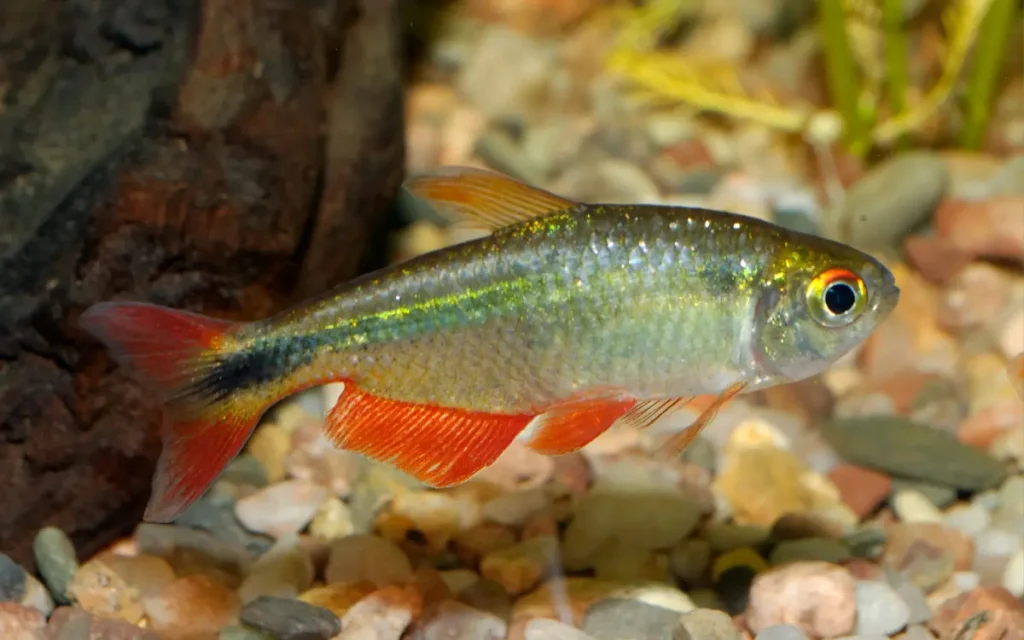
Buenos Aires Tetras are robust, active freshwater fish known for their silver bodies and distinctive red fins. They are hardy and can adapt to a variety of water conditions, making them suitable for beginners. These tetras are schooling fish and should be kept in groups.
Care Requirements
- Tank Size: Minimum of 30 gallons
- Water Temperature: 64-82°F (18-28°C)
- pH Level: 5.8-8.5
- Diet: Omnivorous; high-quality flake food, micro-pellets, and live or frozen foods like brine shrimp and bloodworms
- Lighting: Moderate lighting
- Substrate: Fine gravel or sand
- Plants and Decor: Live plants, although they may nibble on some plant species, along with hiding spots and open swimming areas
- Water Changes: Regular water changes (25% weekly) to maintain water quality
Tank Mates
- Other active, robust fish such as Zebra Danios, Barbs, and larger Tetras
- Bottom dwellers like Corydoras Catfish and Plecos
- Avoid slow-moving or long-finned fish that may be nipped at, such as Bettas or Angelfish.
- Keeping them in groups of at least 6 can help reduce aggressive tendencies and promote natural schooling behavior.
24.Gold Barb (Puntius semifasciolatus)
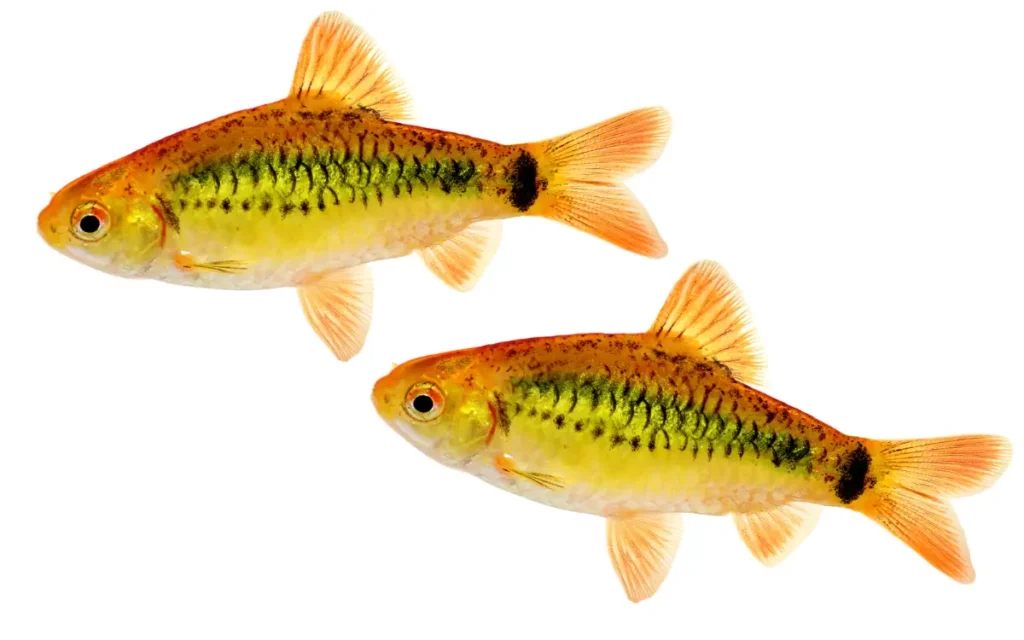
Gold Barbs, also known as Chinese Barbs, are small, hardy freshwater fish known for their striking golden-yellow coloration. They are peaceful and active, making them a popular choice for community aquariums. Gold Barbs are relatively easy to care for, making them suitable for beginners.
Care Requirements
- Tank Size: Minimum of 20 gallons
- Water Temperature: 64-75°F (18-24°C)
- pH Level: 6.0-8.0
- Diet: Omnivorous; high-quality flake food, micro-pellets, and live or frozen foods like brine shrimp and bloodworms
- Lighting: Moderate lighting
- Substrate: Fine gravel or sand
- Plants and Decor: Live plants, driftwood, and rocks to provide hiding spots and create a natural environment
- Water Changes: Regular water changes (25% weekly) to maintain water quality
Tank Mates
- Other peaceful community fish such as Neon Tetras, Harlequin Rasboras, and Corydoras Catfish
- Other barbs like Cherry Barbs and Black Ruby Barbs
- Bottom dwellers like Corydoras Catfish and Otocinclus
- Avoid slow-moving or long-finned fish that may be nipped at, such as Bettas
25.Hachetfish (Gasteropelecus sternicla)

Hachetfish are small, unique freshwater fish known for their hatchet-shaped bodies and ability to jump out of the water. They are surface-dwelling fish and add an interesting dimension to aquariums with their unusual shape and behavior.
Care Requirements
- Tank Size: Minimum of 20 gallons
- Water Temperature: 72-81°F (22-27°C)
- pH Level: 6.0-7.5
- Diet: Omnivorous; high-quality flake food, micro-pellets, and live or frozen foods like brine shrimp and mosquito larvae
- Lighting: Moderate lighting
- Substrate: Fine gravel or sand
- Plants and Decor: Floating plants and other decorations that provide cover and simulate their natural habitat
- Water Changes: Regular water changes (25% weekly) to maintain water quality
- Tank Cover: A tight-fitting lid to prevent them from jumping out
Tank Mates
- Other small, peaceful fish such as Neon Tetras, Harlequin Rasboras, and Corydoras Catfish
- Bottom dwellers like Corydoras Catfish and Otocinclus
- Avoid large or aggressive fish that may harass or eat them
- Best kept in groups of six or more to reduce stress and encourage natural schooling behavior
26.Congo Tetra (Phenacogrammus interruptus)
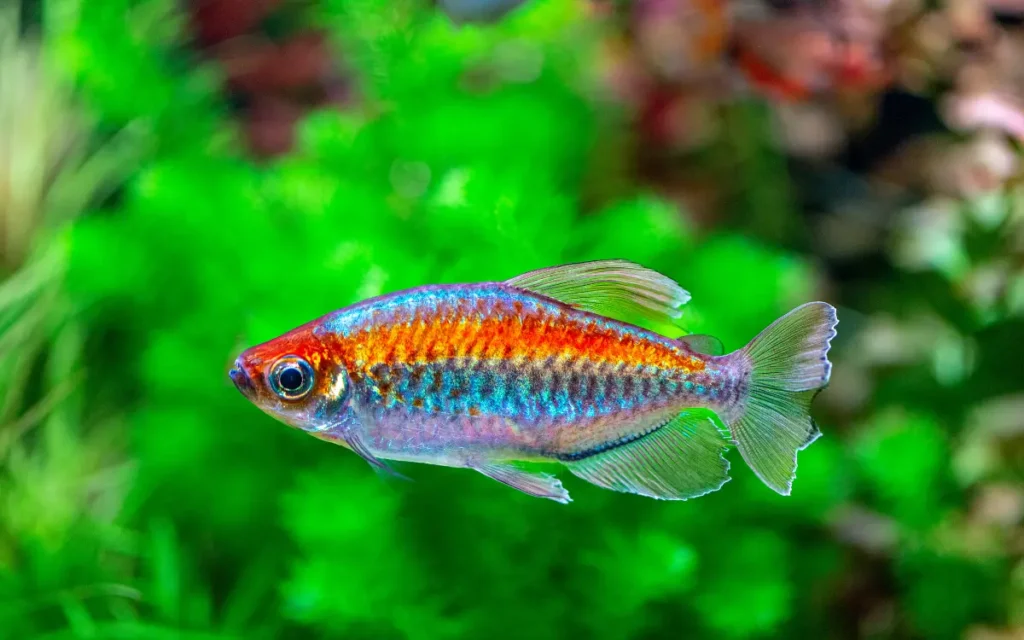
Congo Tetras are medium-sized, peaceful freshwater fish known for their shimmering rainbow coloration and flowing fins. They are active and schooling fish, making them a beautiful and dynamic addition to community tanks.
Care Requirements
- Tank Size: Minimum of 30 gallons
- Water Temperature: 73-82°F (23-28°C)
- pH Level: 6.0-7.5
- Diet: Omnivorous; high-quality flake food, micro-pellets, and live or frozen foods like brine shrimp and bloodworms
- Lighting: Moderate lighting to enhance their iridescent colors
- Substrate: Fine gravel or sand
- Plants and Decor: Live plants, driftwood, and rocks to provide hiding spots and create a natural environment
- Water Changes: Regular water changes (25% weekly) to maintain water quality
Tank Mates
- Other peaceful community fish such as Neon Tetras, Harlequin Rasboras, and Corydoras Catfish
- Other medium-sized tetras and peaceful barbs
- Bottom dwellers like Corydoras Catfish and Plecos
- Avoid large or aggressive fish that may harass or intimidate them
- Best kept in groups of at least 6 to encourage natural schooling behavior and reduce stress
27.Head and Tail Light Tetras (Beacon Fish) (Hemigrammus ocellifer)
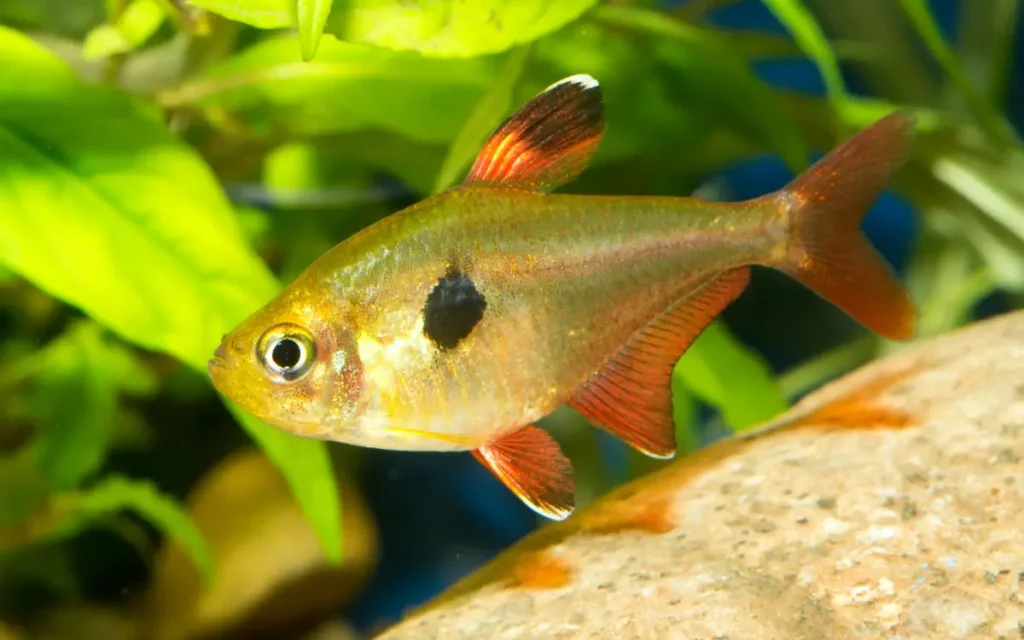
Beacon Fish, also known as Head-and-Tail Light Tetras, are small, peaceful freshwater fish named for the distinctive, reflective spots near their heads and tails. They are active and schooling fish, making them an excellent choice for community tanks.
Care Requirements
- Tank Size: Minimum of 10 gallons
- Water Temperature: 72-82°F (22-28°C)
- pH Level: 6.0-7.5
- Diet: Omnivorous; high-quality flake food, micro-pellets, and live or frozen foods like brine shrimp and bloodworms
- Lighting: Moderate lighting to highlight their reflective spots
- Substrate: Fine gravel or sand
- Plants and Decor: Live plants, driftwood, and rocks to provide hiding spots and create a natural environment
- Water Changes: Regular water changes (25% weekly) to maintain water quality
Tank Mates
- Other small, peaceful fish such as Neon Tetras, Harlequin Rasboras, and Guppies
- Other tetras to enhance schooling behavior
- Bottom dwellers like Corydoras Catfish and Otocinclus
- Avoid large or aggressive fish that may harass or eat them
- Best kept in groups of at least 6 to encourage natural schooling behavior and reduce stress
28.Pearl Danio (Danio albolineatus)
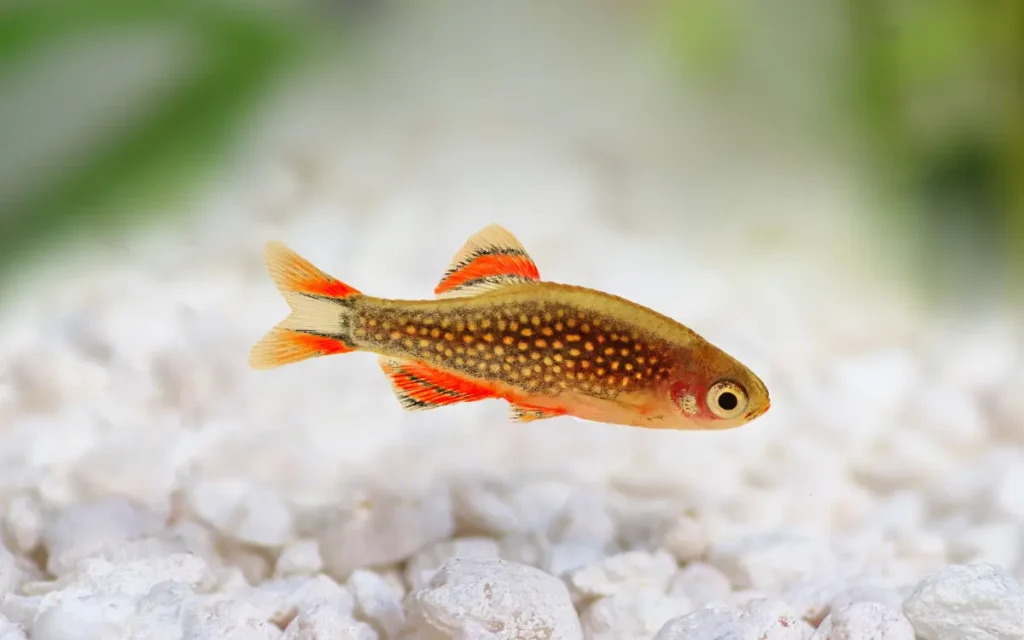
Pearl Danios are small, hardy freshwater fish known for their beautiful pearlescent sheen and active swimming behavior. They are peaceful and make excellent additions to community tanks, adding both movement and subtle coloration.
Care Requirements
- Tank Size: Minimum of 10 gallons
- Water Temperature: 64-75°F (18-24°C)
- pH Level: 6.0-8.0
- Diet: Omnivorous; high-quality flake food, micro-pellets, and live or frozen foods like brine shrimp and daphnia
- Lighting: Moderate lighting to enhance their pearlescent colors
- Substrate: Fine gravel or sand
- Plants and Decor: Live plants, rocks, and driftwood to provide hiding spots and simulate their natural habitat
- Water Changes: Regular water changes (25% weekly) to maintain water quality
Tank Mates
- Other small, peaceful fish such as Neon Tetras, Harlequin Rasboras, and Guppies
- Other danios to enhance schooling behavior
- Bottom dwellers like Corydoras Catfish and Otocinclus
- Avoid large or aggressive fish that may harass or eat them
- Best kept in groups of at least 6 to encourage natural schooling behavior and reduce stress
Why Choose Small Freshwater Fish?
Ease of Care and Maintenance
Small freshwater fish are generally easier to care for and maintain than larger species.
They require less space, consume less food, and produce less waste, making them ideal for beginner aquarists. Their smaller size also means that they are less demanding in terms of water quality and tank maintenance.
Compatibility with Various Tank Sizes
Small freshwater fish are well-suited to a wide range of tank sizes, from small desktop aquariums to larger community tanks.
This versatility allows hobbyists to create diverse and interesting aquatic environments without needing large or complex setups.
Variety of Species and Colors
The world of small freshwater fish is incredibly diverse, offering a wide array of species and colors to choose from.
Whether you’re looking for vibrant tetras, lively barbs, or peaceful corydoras, there is a small fish to suit every preference and tank setup.
Cost-Effectiveness
Small freshwater fish are typically more affordable than larger species, both in terms of initial purchase and ongoing care.
They require less food and smaller tanks, which can significantly reduce the overall cost of setting up and maintaining an aquarium. This makes them an attractive option for budget-conscious aquarists.
